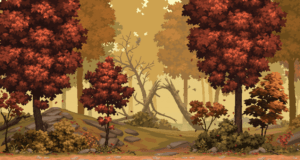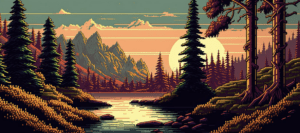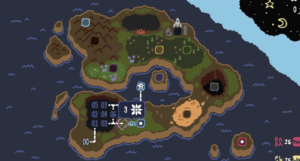Spiritwood (name in progress)

As you awaken in a deep forest, you’re plagued with questions. “Where am I?” “Why am I here?” and “Who am I?” taunt you relentlessly. However, instead of succumbing to frustration, you resolve to explore your surroundings. It’s not long before you realize that a sinister force is at work in the woods… Amidst the chaos, you discover your ability to converse with a magical squirrel that guides you along your path. Throughout your journey, you will interact with various creatures and harness their unique skills – from flying to swimming and shielding.
Synopsis
The game is a philosophical journey embedded with fun animal puzzles.
Your objective is to employ these special abilities as power-ups, systematically unraveling the enigmatic puzzles of dark magic. With each puzzle you solve, you move one step closer to answering the questions that have been weighing on your mind.
Story & Setup
As you slowly open your eyes, you feel the warmth of the sun on your face and hear the gentle rustling of leaves above you. Blinking away the grogginess, you sit up and take in your surroundings. You find yourself in the heart of a lush forest, surrounded by towering trees and a canopy of greenery that stretches as far as the eye can see. You try to remember how you got here, but your memory fails you. You can’t recall your name or where you came from, or even why you’re here.
Lost and disoriented, you start to explore the forest, hoping to find some answers. As you walk, you stumble upon a small clearing where you see a squirrel perched on a nearby tree branch. You freeze, surprised to see the small creature staring back at you with intelligent, knowing eyes.
To your amazement, the squirrel begins to speak, its tiny mouth moving in perfect synchronization with its words. It tells you that you are the chosen one, the only one who can save the forest from a terrible fate. At first, you’re skeptical – how could a talking squirrel be real? But the sincerity in the creature’s voice and the urgency in its eyes convince you that it’s not a joke.
Despite your confusion, you agree to help the squirrel in its quest to restore balance to the forest. As you journey deeper into the woods, you begin to realize that there’s something special about this place – an ancient magic that’s been hidden away for centuries. And as you uncover more about your role in this enchanted world, you realize that you may be the only hope for saving the forest from destruction.
Tone
The tone of the game (talking to forest critters, instructions) is meant to be friendly yet still obscure. This means that the player feels welcome in the forest yet does not quite know what to make of it. This shouldn’t deter the player from discovering what lies in its depths, however, and should encourage the player to learn more about what the forest may be hiding. The tone is thus friendly, mystical, and mysterious.

Setting
The story takes place in a mystical and imaginative forest. It is the habitat of a lot of animals, even imaginative ones.
There are supernatural forces involved in the game. The player needs to get used to different tools and powers from different animals encountered. After mastering those techniques, the player can then challenge the final boss to help save the forest.
The forest setting can make the environmental problem metaphor simpler to represent. Besides, it is easy to add hidden plots in the vast forest, such as in the leaf, in a tree branch, etc., and each of those locations can also have different meanings. We can also design different creatures hidden in the forest for the player to explore, based on different features of different parts of the forest.
Gameplay
Our core gameplay revolves around solving puzzles and talking to the animals to piece together the mystery of the forest. We are currently considering having our level selection be an interactive map (similar to Mario Bros or Baba Is You), where besides being able to select previous and current levels, the player can walk around the environment and interact. However, once within a level, our game will take a classic platformer approach.
Even though we want good movement, mechanically challenging gameplay won’t be our focus (especially because we want casual players to enjoy this game). Rather, we want to introduce interesting mechanics for puzzles. We are considering there to be two sections. While the player can walk around a forest in a top-down style,
References

Challenges
Design
We’re going to use Aseprite to design everything for the game. Aseprite is the industry standard for pixel games. There’s a little bit of a learning curve, especially for some of us who don’t have experience with character design/shading. But we have already started to sketch some things out and test out some characters, animals, and background set pieces and they are looking good.
The biggest pure design challenge is going to be designing entire backgrounds. We would like each level to feel different from the next. Each level takes place in our forest setting, but not all parts of a forest look the same. Some levels will take place on the forest floor, in the trees, and up in the leaves, at all different times of the day. This poses some design challenges since we would need to design each type of atmosphere at each time of day.
In terms of the design affecting gameplay, our biggest challenge centers around the fact that we want each level to be approachable from different gameplay styles. If a player wants to go into a level using their “hedgehog” and “spider” abilities one time, and then the next time use the “snail” and “hawk” abilities, each playthrough should feel different and unique. This requires meticulous level design and making sure that we accommodate all possibilities. At its core, we want to design each ability to be fun and provide a different gameplay style for the player.
Tech
The main challenge is the lighting system. Since it’s in a forest, because of the various heights and various densities of leaves of those different trees, the sunlight might be distorted. Besides, different times of the day would also render different lightning, sometimes brighter and sometimes darker. We might also need to add player-controlled flashlights or candlelight for tree holes, and fog in the morning.
Another challenge is the actual implementation, eg. player interaction with the game. It takes power to make sure our deliverable actually matches the design doc.
Art
The main challenge for art is to create consistent 8-bit style artwork with sufficient details like shading. To achieve consistency, we need to follow our color palette and determine styles of line angles and curves. Moreover, to achieve a fun game experience, we need to animate the pixel characters, including the player and the different animals.
Target Audience
This game is for players who enjoy puzzle challenges and a discovery-based progression in games. By creating different combinations of powers a player can use, we introduce the mechanic of choosing their own mechanics for the players.
Potential players also include those who like cute, 8-bit style games with inviting visuals and a playful yet mysterious energy. This game is designed to play single-player, meaning that it is not ideal for those wishing to play in groups.
Appendix
Jamie: https://mechanicsofmagic.com/2023/05/08/checkpoint-1-individual-deliverables-2/
Janet: https://mechanicsofmagic.com/2023/05/08/checkpoint-1-individual-deliverables_janet/
Defne: https://mechanicsofmagic.com/2023/05/08/concept-mood-defne/
Eli: https://mechanicsofmagic.com/2023/05/08/18956/
Pedro: https://mechanicsofmagic.com/2023/05/09/checkpoint-1-concept-doc-individual-12/



